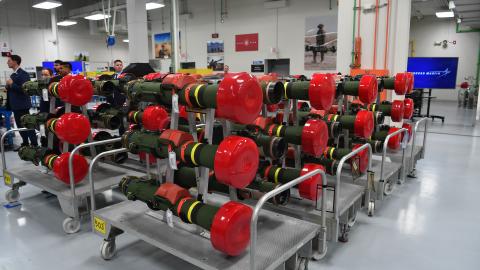As the second year of the war in Ukraine gets underway, American defense planners are growing worried. To supply the Ukrainians, the U.S. and its allies are exhausting their stockpiles of missiles and munitions and potentially leaving themselves vulnerable. The documents recently leaked by Jack Texeira only reveal what everyone already knows: Ukraine is low on ammo. The Ukrainians are using to good effect the artillery shells, surface-to-surface missiles, and man-portable Javelin and Stinger missiles they are receiving, but every shell and missile that goes to Ukraine is one less in the U.S. arsenal.
This problem is growing more acute as China’s military buildup tilts the balance of power in the western Pacific and makes a major war there more likely. Some are now calling for the United States to cut off support for Ukraine and focus on China. Ignoring that nine NATO allies have sent more aid to Ukraine as a share of their GDP than the U.S. has, Sen. Josh Hawley demanded in February that “we should cut off U.S. military aid to Ukraine, until our European allies step up.”
The China-versus-Russia debate obscures a bigger set of issues that affect our national security. Many of the weapons and munitions on their way to Ukraine would have limited utility in a fight in the Pacific Ocean, but there are some, such as Javelin and Stinger missiles, that both the Ukrainians and the Taiwanese need. The United States is sending Ukraine some of its own supplies of Javelins and Stingers, both of which it also sold to Taiwan in 2015 but still has not delivered. The very long delay is part of a larger problem for Americans, their partners and their allies: The United States cannot produce needed weapons quickly, and it has little ability to ramp up production in an emergency.
The Javelin missile debacle reveals many of the problems that impair America’s ability to arm and equip the U.S. military and its partners. After eight years of delays, Taiwan will finally begin receiving Javelins in the second half of 2023. However, they are far from the only weapons that the Taiwanese are waiting for, and some may take more than eight years to arrive. The United States announced in 2020 that it will sell Harpoon anti-ship missiles to Taiwan, but those may not arrive until 2029. In December, the total backlog to Taiwan approached $19 billion, greater than Taiwan’s total purchases during the Trump and Biden presidencies combined.
Ramping up production for even relatively uncomplicated weapons like the Javelin takes quite a bit of time. Some of its components, such as the rocket motors that power the missile, are made by only one company. Lockheed Martin is doubling its production of Javelins, but CEO Jim Taiclet warned “that will take a number of months, maybe even a couple of years to get there because we have to get our supply chain to also crank up.” As he put it in December, the problem is that “the U.S. defense industrial base is scoped for maximum efficiency at peacetime production rates,” not for fighting a major war, let alone supporting the many wars that are cropping up globally.
This problem affects nearly every important weapon made in America. At the end of the Cold War, the U.S. enjoyed a “peace dividend” as it cut defense spending from 6% of America’s GDP to 3%, freeing up $1.7 trillion from 1989 to 2000. The Navy dwindled from 592 ships in 1989 to 318 in 2000, the Air Force lost one-third of its aircraft during the same time period, and the Army shrank from 18 active duty divisions to 10. Some of these cuts seemed to make sense at the time—after the Soviet Union collapsed, a large defense budget was difficult to justify—but as the international situation has grown more threatening, undoing that scale-back has been hard.
The defense industrial base, the companies that arm and equip the U.S. military and its partners, took a haircut to pay for the peace dividend. At the end of the Cold War, there were 51 so-called prime contractors, and after a wave of cuts and consolidations only five were left standing. This shift initially appeared to mostly benefit the military and its suppliers. As other countries cut their defense budgets faster and deeper than the United States did, the primes had fewer customers and needed to focus on meeting the Pentagon’s requirements. The Pentagon could only squeeze the primes so hard though, since even the most penny-pinching program managers wanted to avoid ending up with only one supplier of advanced weapons systems.
However, the wave of consolidation has made some projects, particularly big-ticket items that defense contractors build their futures on, too big to fail. Late Sen. John McCain denounced the F-35 fighter jet as “a scandal and a tragedy with respect to cost, schedule and performance,” but there was little he could do about it. Lockheed Martin would be in jeopardy if the F-35 were canceled, and the Air Force, Marines, and Navy had no other options waiting in the wings. Big companies like Raytheon and Boeing attract a lot of media attention and a fair share of critical coverage for filling their corporate boards with retired admirals and generals and for habitual cost overruns, but there are other problems that the media often overlooks.
The post-Cold War squeeze impacted “the little guys” as well. Ryan Boone, a director at the Telemus Group and former senior analytic adviser in the Pentagon’s Office of the Secretary of Defense, says there has also been significant “consolidation in the second and third tiers” of the defense industrial base. These more obscure companies make highly specialized products for, ultimately, one customer: Uncle Sam. According to Boone, many of these companies are small businesses, niche shops, or, in the most extreme cases, just “one guy” making critical components. If these often-overlooked specialists get sick, retire, or find more lucrative work, some advanced weapons cannot be repaired or produced until an alternative solution is found.
These companies often make components for multiple weapon systems. In an emergency, they would be challenged to increase production sufficiently to satisfy all demands that may arise. For example, there are two American companies that produce rocket motors for the U.S. military. One of them, Aerojet Rocketdyne Holdings, has a backlog of orders “approximately three times our annual sales,” according to CEO Eileen P. Drake. Williams International makes the turbofan for every cruise missile the Pentagon orders. A 2018 DOD report found that 98% of “critical components” for “key munitions” had only one source.
“This is an enormous problem. It’s not just specific to munitions, it applies across the board,” according to a congressional aide. In some cases, “at the secondary and tertiary level, there is no competition,” which can drive up prices. A single act of sabotage, industrial accident or hacking attack can also take out entire production lines: In 1996, one contractor decided to stop making the only source of a military rocket propellant rather than repair damage from a fire, and a Louisiana factory that makes critical components of over 300 munitions has yet to reopen after an accidental explosion two years ago. Presumably the Chinese, among others, have noticed this vulnerability.
These are not good problems to have as the global balance of power teeters precariously. Xi Jinping has said that “the world faces great changes unseen in a century,” and Rush Doshi, the National Security Council’s China director, warns that Xi’s declaration “helps mark a new phase in PRC grand strategy—a global one.” As if to reveal what changes he has in mind, Xi said to Vladimir Putin on his most recent Moscow trip, “now there are changes that haven’t happened in 100 years. When we are together, we drive these changes.” When they were together in February 2022, Xi and Putin announced a “no limits” partnership. Putin attacked Ukraine that month. Xi has his own target list, and Taiwan is at the top.
The need to defend Taiwan is growing more urgent as the Chinese military prepares for 2027, the date that Xi Jinping has ordered it to be ready to conquer Taiwan. Rep. Mike Gallagher has called for Taiwan to move to the front of the line for weapons such as Harpoon missiles. Others caution that the Saudis have already signed a contract and paid for the ones in production, and a legal challenge could ensnarl the entire missile production line. Moreover, relations between Riyadh and Washington are rocky right now, and publicly downgrading our defense partnership with Saudi Arabia could cause greater strategic headaches.
As the congressional aide I spoke to noted, “there is no way to fix this in the near term.” However, if Congress and the Defense Department incentivize long-term investments, defense companies should build the capacity the U.S. would need in a major war and thus demonstrate to China that a sneak attack will not succeed.
To make this happen, Congress will need to do one of its most basic jobs: write and pass a budget. The National Defense Industrial Association laments “in 13 of the last 14 years, the federal government has operated under a continuing resolution (CR) for part of the year,” which has frozen funding and discouraged defense companies from making needed investments. Arthur Herman, a senior fellow at Hudson Institute who wrote Freedom’s Forge, a history of the defense industrial base during World War II, said CRs “do incalculable damage to the industrial base, by making it almost impossible to enter new orders for equipment, etc., except with emergency orders.” Air Force Chief of Staff C.Q. Brown Jr., who is likely to be the next chairman of the Joint Chiefs of Staff, warns that another CR would “give our adversaries a year to move forward” while the military loses the ability to change course. “You can’t buy back time.”
As a stopgap, the military can also offer longer contracts. Nadia Schadlow, a senior fellow at the Hudson Institute and a co-chair of the Hamilton Commission, says that the Biden administration’s decision to procure some munitions for multiple years at a time is helpful, but “these steps don’t address the need to modernize facilities.” This is a problem because some naval shipbuilding and repair centers, and some munitions factories, “date back to World War II.”
Congress can also make it easier to sell weapons to other countries so American companies have more customers, and so that those countries can share some of the U.S. military’s burdens. Boone pointed out that the Foreign Military Sales process has a lot of hurdles: The purchasing country, the State Department, the Defense Department, and Congress all have to agree on what weapons to sell, and “the process can be much slower if the country is a strategic priority,” because more people want to add their input. To Schadlow, because no single organization is responsible for making FMS work, “it is the worst of what whole-of-government can produce.” Moreover, the regulations governing FMS were written during the Cold War when the distinction between civilian and military technologies was clearer. As dual-use technologies have proliferated, the process has proven “stubbornly resistant to modernization.”
But will it? There are some indications that Congress is rising to meet the China challenge, such as the China commission that is investigating Chinese belligerence and ways to defend against it, and the bipartisan push to prevent Biden from letting inflation cut the defense budget. However, “over the last decade and a half Congress has managed to come up with the two budget processes that do the most damage to our national security, CRs and sequestration,” Herman noted. “That’s an astonishing record.”
America’s political leadership misjudged the Chinese Communist Party as China undertook one of the largest peacetime military buildups in history and destroyed millions of American jobs through predatory trade practices. A second failure, to respond adequately to a stronger and emboldened China, will be even costlier.

















